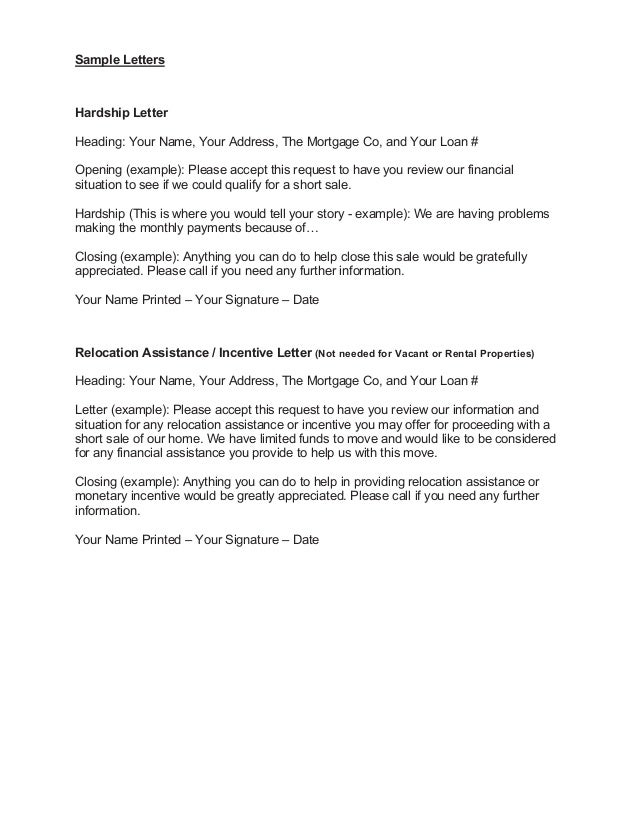Hardship Letter Additional Income
Recognizing eligible hardships. You need to prove that you experienced a genuine hardship and that it compromised your ability to pay. Most lenders give consideration to the following hardships, among others: Job loss or relocation, such as a layoff or reduction in force (RIF). Income reduction, such as a wage reduction or loss of overtime.
 You'll need to offer potential solutions to the lender so that you can work together with them to modify your loan. Think about your loan needs and suggest a loan modification that you think would be fair to your lender and allow you to get out of current financial hardship. For example, consider the following modifications:
You'll need to offer potential solutions to the lender so that you can work together with them to modify your loan. Think about your loan needs and suggest a loan modification that you think would be fair to your lender and allow you to get out of current financial hardship. For example, consider the following modifications:- If your interest rate has increased to an unmanageable level, consider asking for a reduction in that interest rate.
- If you are behind on your payments, ask for your lender to grant you a temporary reduction in payments and a plan to repay the back payments over time after your situation improves. When you do this, make sure that the amount you offer is something you can actually afford right now.
- If your home is less valuable than the balance of your loan (due to falling home prices), you may be able to get your lender to decrease the balance of your loan.[5]
- Make sure to state your request in clear terms. For example, don't say, 'I want lower payments.' Instead, try saying, 'I would be able to afford payments of $500 per month for the next three months, at which point I could resume paying my current payments.'
When applying for a home loan modification, a key component of the application is the hardship letter, the homeowners’ description of the financial setbacks they’ve experienced that resulted in their inability to pay their monthly mortgage.
Recognizing eligible hardships
Medical Hardship Letter
Not everything qualifies as a bona fide financial hardship. You need to prove that you experienced a genuine hardship and that it compromised your ability to pay.
Most lenders give consideration to the following hardships, among others:
Job loss or relocation, such as a layoff or reduction in force (RIF).
Income reduction, such as a wage reduction or loss of overtime.
A failed business or one that’s suffering from an economic slowdown.
Divorce or separation.
Newborn child, namely maternity leave and the increased expense of having another dependent. Some lenders even consider adoption a hardship.
Death in the family, especially if the person who passed away was helping to make the payments.
Payment shock, as in a bump in the interest rate on an adjustable-rate mortgage.
Minecraft best mods ever. This mod ‘Still Hungry’ is a way to fulfil you with lots of food so there would be no requirement of searching for food. This is not an unlimited amount of food but there is plenty and you can choose from several options so you can choose your type. Still HungryThe game is all about survival just like any other game and in the Minecraft, you can survive only if you have the least amount of food.
Illness or injury that either reduces income or increases medical expenses or both.
Too much debt accumulated over time.
Military duty.
Gambling by one of the household’s wage earners who’s currently seeking treatment.
Alcohol or drug dependency of one of the household’s wage earners who’s currently seeking treatment.
Incarceration of one of the household’s wage earners.
Questions your hardship letter should answer
Hardship Letter Additional Income Taxes


The people who read your hardship letter come to it with questions they want answered, so you’d better have the answers straight in your own mind first before you put them down on paper. Following are the questions your hardship letter needs to answer:
What event or series of events caused the financial hardship that has made your monthly mortgage payments unaffordable?
When did the hardship occur? Provide a specific date or range of dates.
Is the hardship temporary or permanent? A temporary hardship could be medical bills not covered by insurance, an injury or short-term illness, or a job layoff. A permanent hardship is more like a death in the family or a divorce or separation.
How badly do you want to keep your home? If you really don’t care about keeping the home, the lender may not care enough to try to negotiate a loan modification.
Are you behind on your house payments? If yes, how many months are you behind? What’s the total dollar amount of your deficiency?
Can you afford to make a house payment? If yes, how much can you afford to pay?
What are you doing to address the root cause(s) of the hardship (if you have any control over them) and recover your financial footing? This can be anything from budgeting more carefully to finding a new job or liquidating assets.
The goal of your hardship letter is to convince your lender that you’re worthy of a loan modification. It should show that you meet all the lender’s eligibility requirements and convince the lender that you’re committed to a long-term solution and able to follow through.
Reviewing a sample hardship letter
You should keep your hardship letter short — one page is plenty. Underline the most important points, including the terms of your current loan, the total deficiency amount (if any), the date on which the trouble began, anything you’ve done to resolve the problem, and so on. The following document provides a model for you to get started.